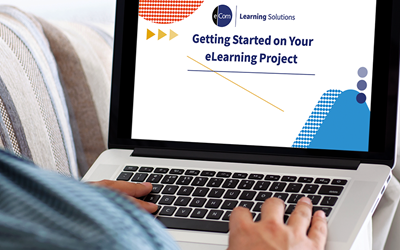Collaboration is key to create sensitive eLearning content
Developing sensitive content for eLearning requires a careful balance of respect, accuracy, and clarity. When working with emotionally charged or delicate topics such as, diversity, inclusion, or mental health, the way content is designed and delivered can significantly impact learner engagement and comprehension.
Collaborating closely with subject matter experts (SMEs) is vital in this process, as their expertise ensures the material is both credible and relevant. Navigating this partnership can be complex, but by collaborating with subject matter experts (SMEs), an Instructional Designer can craft content that doesn’t just inform but resonates, especially when dealing with sensitive material.
Posted 18 September 2024
1. Understanding the sensitivity of the subject matter
Before diving into content creation, it’s important to have a deep understanding of the sensitivity of the topic. Sensitive subjects often touch on personal, emotional, or cultural aspects of life. Instructional designers, in collaboration with SMEs, need to be aware of these nuances. For instance, if you’re creating eLearning materials on mental health or diversity training, it’s essential to recognise that learners may have personal experiences related to these topics. Every word must be crafted with care to honour those personal experiences without alienating learners as these subjects can evoke strong reactions, either positive or negative, depending on how the content is framed.
The instructional designer plays a key role in shaping the delivery of this content, ensuring that the sensitive material is presented in a way that fosters understanding and empathy, allowing learners to engage with potentially challenging material.
2. Building empathy into the learning experience
When creating content on sensitive topics, empathy is vital. Instructional designers are tasked with ensuring that the course not only provides information but does so in such a way that learners feel respected, understood, and included as they engage with the material. Working with SMEs, they can translate technical or clinical details into relatable, humanised learning experiences. Content should be non-judgemental and inclusive, avoiding language or scenarios that could alienate or trigger learners.
The instructional designer’s expertise lies in translating the SME’s knowledge into interactive, scenario-based learning. These activities allow learners to engage with the content in a safe environment. The designer must ensure the structure of the eLearning programme allows learners to process the information at their own pace, which is particularly important with sensitive topics. The best eLearning isn’t just about ticking off learning objectives; it’s about creating moments of realisation.
3. Collaborating with subject matter experts
The relationship between instructional designers and SMEs is crucial to the success of the eLearning project. Each bring something unique to the table: the SME provides deep subject knowledge, while the instructional designer shapes that information to ensure it is engaging and accessible. When working on sensitive topics, it is important to find a balance that encompasses both types of expertise and work collaboratively.
One of the instructional designer's key responsibilities is to facilitate open communication with the SME. This helps establish the boundaries of the content, ensuring both parties are aligned on how to handle sensitive material. The designer asks open-ended questions, listens carefully to the SME’s insights, and then shapes those into a format that is educational, respectful, and engaging.
However, the instructional designer must also guide the SME on pedagogical best practices. Sometimes SMEs may focus too heavily on technical accuracy, making the content too complex or overwhelming for learners or fall into expert blindness, where they may skip over the foundational information that a non-expert needs to understand the more complex content. The designer helps balance this by breaking down the material into manageable, engaging chunks that maintain the integrity of the content without overwhelming learners.
4. Balancing expertise with learner sensitivity
Instructional designers and SMEs must work together to balance technical accuracy with learner sensitivity. While SMEs ensure the information is factually correct, instructional designers ensure it is digestible and empathetic. This balance is particularly important when addressing sensitive issues like mental health, trauma, or diversity, where emotional engagement can be just as crucial as intellectual understanding.
For example, in diversity training, an SME might provide detailed legal frameworks or historical contexts. The instructional designer's job is to translate these into real-world scenarios or stories that learners can relate to, ensuring the course isn’t bogged down by overly academic content. A lot of the time this comes under the wider category of soft skills learning where the aim of the content is not overly focused on passing on academic information and has a greater emphasis on making the learning into something learners can feel and then scaffolding that emotional connection with practical sets that can be taken. This can also mean creating interactive elements, such as decision-making activities, where learners navigate different scenarios based on the principles taught.
5. An iterative process of collaboration and feedback
Developing sensitive eLearning content is not a one-off task. It requires an iterative process, where the instructional designer and SME continuously refine the content based on feedback. They may need to test the content with pilot groups, adjust language or scenarios, and ensure the material remains engaging while meeting all ethical and educational standards.
The instructional designer acts as the bridge between learners and SMEs, allowing the content to evolve as new insights emerge, this helps to ensure that both the SME’s insights and the learner's experiences are fully integrated. They gather feedback not only from the SME but also from learners, this iterative process lends to ensuring that the course resonates with its audience and effectively handles the sensitive nature of the material.
Fostering lasting impact
Creating sensitive eLearning content is a collaborative process that hinges on the relationship between instructional designers and subject matter experts. Both play crucial roles: SMEs provide the necessary knowledge, ensure accuracy and integrity, while instructional designers shape that information into a respectful, engaging learning experience. Through careful communication, mutual respect, and an iterative approach, they can produce eLearning content that not only educates but also resonates with learners on an emotional level, ensuring understanding while maintaining sensitivity. When done right, this is a partnership that can create learning experiences that stick with people long after they’ve logged off.
Recent Posts
eCom Learning Solutions: Staying ahead in a constantly evolving landscapeLevel up your event management with eNetLearn
White-labelling: The secret to training learners actually trust
Turning AI into potential gain
Seamless HR Integration: Streamlining workforce enrolment with eCom's eNet Product Suite



